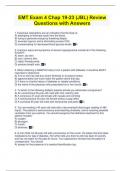Exam (elaborations)
EMT Exam 4 Chap 19-23 (JBL) Review Questions with Answers
- Module
- Institution
1. Kussmaul respirations are an indication that the body is: A) attempting to eliminate acids from the blood. B) trying to generate energy by breathing deeply. C) severely hypoxic and is eliminating excess CO2. D) compensating for decreased blood glucose levels. A 2. Common signs and symptom...
[Show more]



